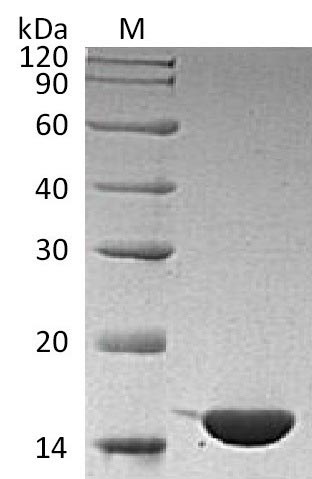Recombinant Human Interleukin-36 gamma (IL36G) (Active)
CAT:
399-CSB-AP004561HU-01
Size:
1 mg
Price:
Ask
- Availability: 24/48H Stock Items & 2 to 6 Weeks non Stock Items.
- Dry Ice Shipment: No




Recombinant Human Interleukin-36 gamma (IL36G) (Active)
- CAS Number: 9000-83-3
- Gene Name: IL36G
- UniProt: Q9NZH8
- Expression Region: 18-169aa
- Organism: Homo sapiens
- Target Sequence: SMCKPITGTINDLNQQVWTLQGQNLVAVPRSDSVTPVTVAVITCKYPEALEQGRGDPIYLGIQNPEMCLYCEKVGEQPTLQLKEQKIMDLYGQPEPVKPFLFYRAKTGRTSTLESVAFPDWFIASSKRDQPIILTSELGKSYNTAFELNIND
- Tag: Tag-Free
- Source: E.coli
- Field of Research: Immunology
- Assay Type: Active Protein & In Stock Protein
- Relevance: Interleukin-36 gamma (IL-36γ) is a member of the interleukin 1 cytokine family that includes three closely related genes, IL-36α, β, and γ, formerly known as IL-1F6, F8, and F9 respectively. IL-36α has been detected in both neuronal and synovial tissue, whereas IL-36β and IL-36γ are expressed in both cutaneous and mucosal epithelial cells, including the respiratory tract. IL-36β and IL-36γ stimulate proliferation, maturation and/or cytokine expression by innate immune cells (such as keratinocytes and dendritic cells), and adaptive immune cells (neutrophils and T-cells) in both humans and mice. The activity of IL-36α is mediated by interleukin 1 receptor-like 2 (IL1RL2/IL1R-rp2), and is specifically inhibited by interleukin 1 family, member 5 (IL1F5/IL-1 delta). IL-36γ plays an important role in communicating the cell death to surrounding cells.
- Endotoxin: Less than 1.0 EU/µg as determined by LAL method.
- Purity: Greater than 95% as determined by SDS-PAGE.
- Activity: Yes
- Bioactivity: The ED50 as determined by its ability to induce IL-8 secretion in A431 human epithelial carcinoma cells is 5-20 ng/ml.
- Length: Full Length of Mature Protein
- Form: Lyophilized powder
- Buffer: Lyophilized from a 0.2 μm filtered 20 mM Tris-HCl, 100 mM NaCl, 0.1 mM EDTA, pH 8.0
- Reconstitution: We recommend that this vial be briefly centrifuged prior to opening to bring the contents to the bottom. Please reconstitute protein in deionized sterile water to a concentration of 0.1-1.0 mg/mL.We recommend to add 5-50% of glycerol (final concentration) and aliquot for long-term storage at -20℃/-80℃. Our default final concentration of glycerol is 50%. Customers could use it as reference.
- Function: Cytokine that binds to and signals through the IL1RL2/IL-36R receptor which in turn activates NF-kappa-B and MAPK signaling pathways in target cells. Part of the IL-36 signaling system that is thought to be present in epithelial barriers and to take part in local inflammatory response; similar to the IL-1 system with which it shares the coreceptor IL1RAP. Seems to be involved in skin inflammatory response by acting on keratinocytes, dendritic cells and indirectly on T-cells to drive tissue infiltration, cell maturation and cell proliferation. In cultured keratinocytes induces the expression of macrophage, T-cell, and neutrophil chemokines, such as CCL3, CCL4, CCL5, CCL2, CCL17, CCL22, CL20, CCL5, CCL2, CCL17, CCL22, CXCL8, CCL20 and CXCL1; also stimulates its own expression and that of the prototypic cutaneous proinflammatory parameters TNF-alpha, S100A7/psoriasin and inducible NOS. May play a role in proinflammatory responses during particular neutrophilic airway inflammation
- Molecular Weight: 17 kDa
- Storage Conditions: The shelf life is related to many factors, storage state, buffer ingredients, storage temperature and the stability of the protein itself. Generally, the shelf life of liquid form is 6 months at -20℃/-80℃. The shelf life of lyophilized form is 12 months at -20℃/-80℃.
